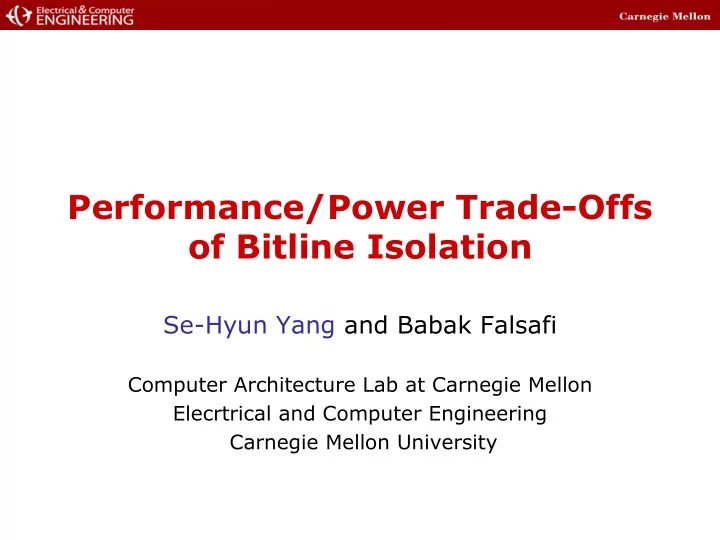

Performance/Power Trade-Offs of Bitline Isolation Se-Hyun Yang and Babak Falsafi Computer Architecture Lab at Carnegie Mellon Elecrtrical and Computer Engineering Carnegie Mellon University
High Bitline Discharge in Caches Deep sub µ high-performance caches • Use subarrays • Precharge entire caches statically • No precharging delay exposed … … … Large discharge from subarrays
Bitline Isolation Stop discharge by cutting off V dd -bitline path • A.k.a. leakage biased bitlines • Turn off precharge devices … … … Need selective mechanisms to control
Per-access Precharging Control Ideally, best for energy saving • All bitlines isolated initially • Precharge only accessed subarrays • On-demand wakeup using partial decoding … … … Can be done for free? Energy cost, Timeliness
Contributions Bitline Isolation • Energy: Large cost before, not in the future Per-access control viable in the future • Performance: On-demand wakeup is late Early precharging is required • Ideal early precharging Vs. Resizable caches Large opportunity (74%) for per-access control
Methodology CACTI 3.0 and SPICE simulations • 180nm-2V,130nm-1.7V,100nm-1.3V,70nm-1V Highly modified Wattch 1.0 • 12 SPEC benchmarks • 8-wide 64 Issue queue w/ 128 Active list • 32KB 2-way set associative L1 caches
Outline • Introduction • Methodology • Energy Overhead • Performance Overhead • Per-access Vs. Resizable Caches • Conclusions
Bitline Leakage in SRAM cell Vdd Vdd Precharge BL BL Wordline Leakage occurs in all subarrays Bitline isolation: turn off bitline devices
Sources of Energy Overhead Switching precharge devices Charging up discharged bitlines
Implications What affects energy overhead? • CMOS technology: Relatively larger wire cap • Precharge device size � Resistive load between V dd -bitlines on cell read � Fast pull-up • Subarray size • Discharging time: average cache access interval
Energy Overhead: Results 2.0 180nm 100nm er bitline isolation 130nm e average pow 1.5 70nm s tatic pullup 1.0 elativ 0.5 R 200ns 400ns 0 Interval betw een tw o subarray ac cess es Bitline isolation energy effective in the future
Performance Impact On-demand precharging • Precharge only accessed subarrays • On-demand wakeup using partial decoding Wordline Address Decoding Assertion ? Bitline Precharging Partial Address Decoding
Cache Decoder Architecture decoder decoder Address subarray decoder subarray decoder subarray subarray Stage 1 3-to-8 Address 3-to-8 Stage 2 Stage 3
Implications What affects the delay? • Precharging delay � CMOS technology: Longer wire delay � Size of subarray • Partial address decoding � # of subarrays: More bits for indentifying subarray
Performance Impact: Results Subarray Feature Stage 3 Bitline size precharge(ns) Size (nm) Delay (ns) 180 0.15 0.39 1KB 130 0.13 0.31 100 0.09 0.24 32-row 70 0.06 0.16 180 0.18 0.50 4KB 130 0.13 0.36 100 0.10 0.28 128-row 70 0.07 0.19 Early precharging is desirable
Per-Access Vs. Resizable Caches Resizable caches [Albonesi][Yang et. al] • Monitor/Adapt infrequently • Energy/time overhead amortized in large interval � Important in the past, not in the future • Possibly suboptimal control � Coarse-grain � Less sensitive
• 70nm technology • 74% opportunity for instruction caches Reduction (%) in bitline discharge 100 ammp 20 40 60 80 0 applu apsi compress Opportunity gcc ijpeg m88ksim su2cor swim tomcatv vortex vpr AVG .
Comparison: Resizable Caches 70 Reduction (%) in bitline discharge 50 30 Perfect Prediction Resizable Cache 10 -10 180nm 130nm 100nm 70nm Resizable caches: consistent over technologies Per-access control: capturing opportunity
Conclusions • Smaller energy overhead in the future Per-access fine control viable in the future • On-demand wakeup is late Early precharging to avoid performance hit • 74% opportunity for per-access control for 70nm Significantly less opportunity for the past Resizable caches good for the all generations
For more information PowerTap Project http://www.ece.cmu.edu/~powertap Computer Architecture Lab Carnegie Mellon University
Recommend
More recommend